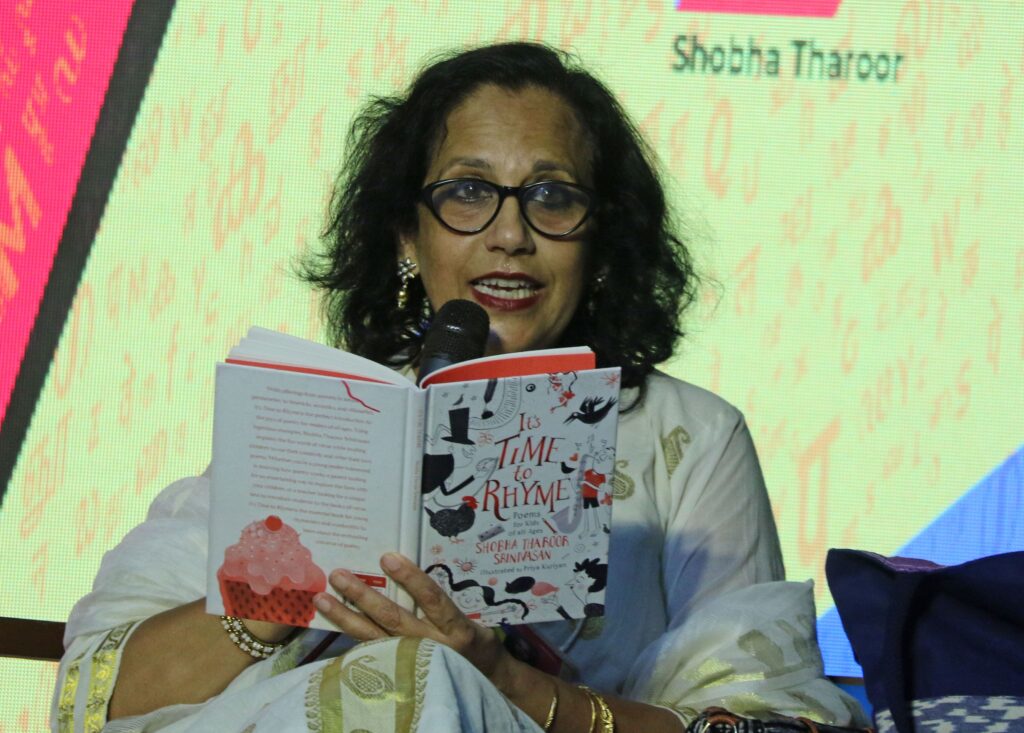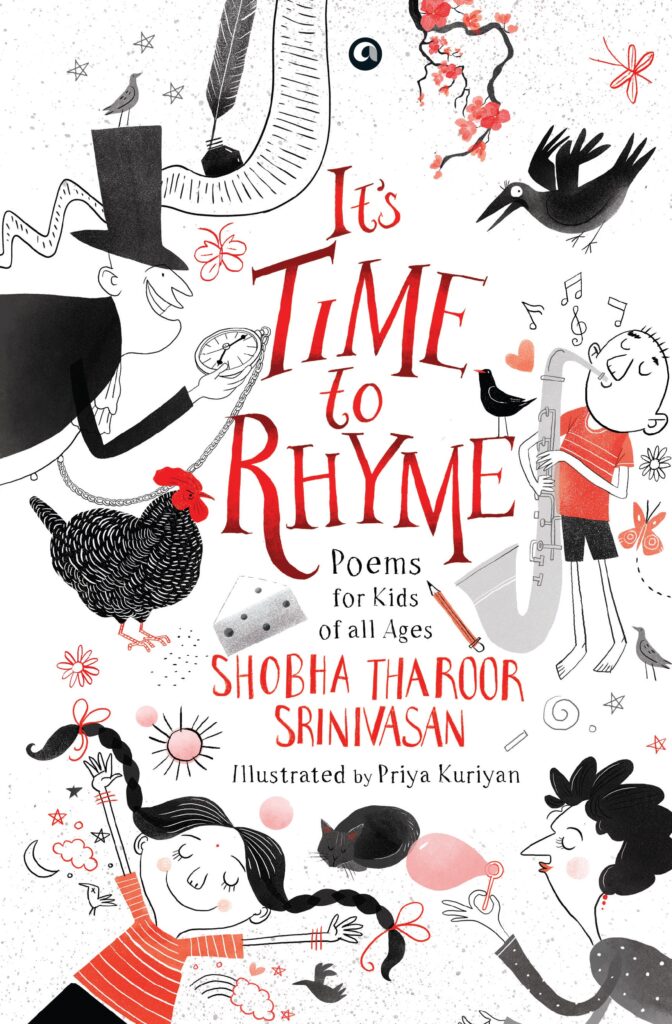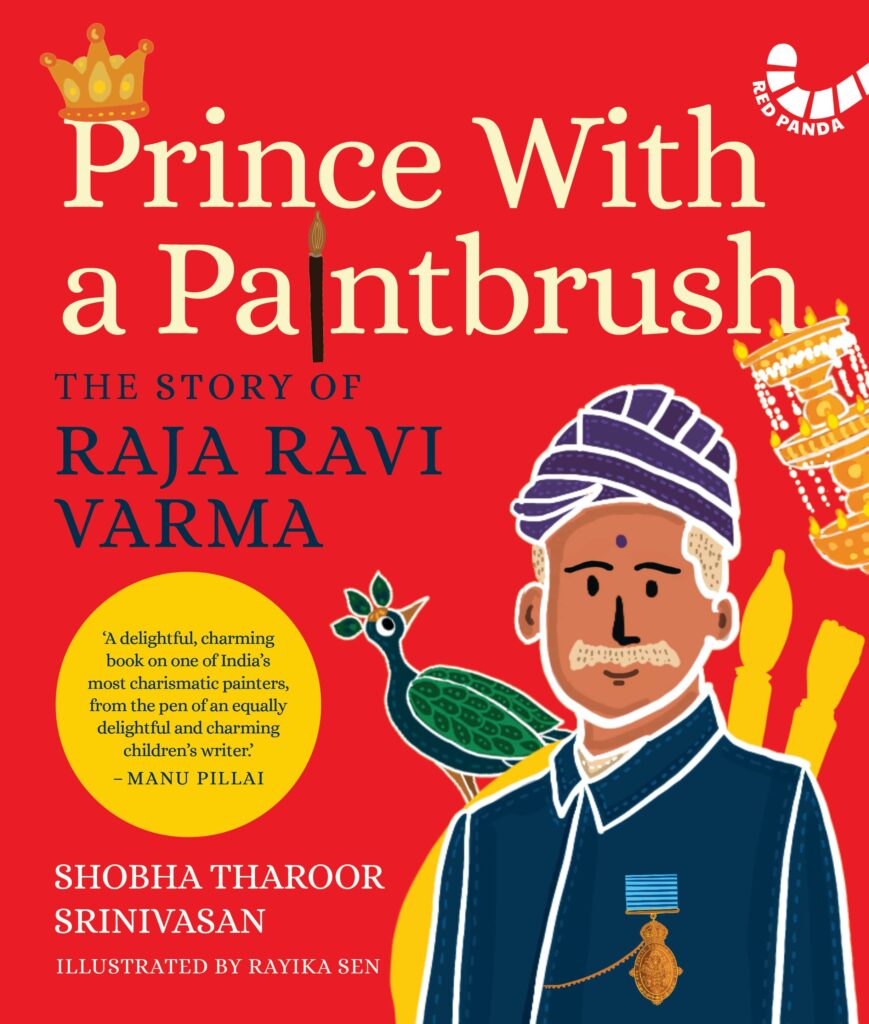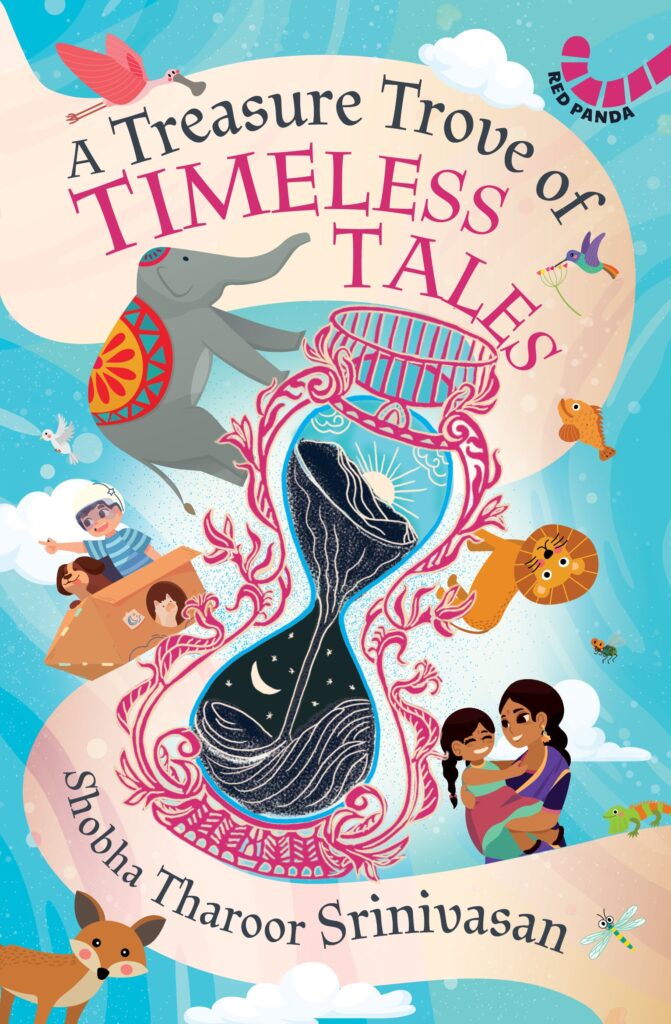Chintan Girish Modi

Shobha Tharoor Srinivasan loves writing for children. Whether it’s a book of poems or a collection of short stories, an artist’s biography or a picture book, she has done it all. I met her at the Apeejay Kolkata Literary Festival in Kolkata in January 2023 and the Mathrubhumi International Festival of Letters in Trivandrum a month later. I was struck by her warmth and energy, her eyes full of curiosity and her spontaneous sense of humour – all of which I feel are important qualities in order to be able to write engaging books for children. In this interview, she talks about her work, pauses to reflect on her own childhood experiences and offers some useful suggestions about how her books can be used as classroom resources.
Q: Your book It’s Time to Rhyme: Poems for Kids of All Ages (Aleph Book Company, 2022) presents itself as “a poetry reader and an instructional text that should serve to dispel fears of rhyme schemes and rigid structure”. Why do formal aspects of poetry seem frightening to some children?

A: Poetry seems to have an image problem with some readers. It has been talked about as opaque, as using figurative language, as not being easily understood, and as being rule driven in terms of structure. Prose, on the other hand, is presented as straightforward and simple.
It is true that information is often compressed in a few words in many poems, so children have to pay attention to the words they read in order to glean the meaning. But, as I show in my book It’s Time to Rhyme, poems can be fun to read and easy to understand when they present relatable ideas and thoughts in simple ways.
Q: Did you enjoy reading, writing, and reciting poetry as a child? Or were you afraid?
A: I loved reading, writing, and reciting poetry as a child and that’s precisely why I am so keen to share that affection for poems with children. As a child I enjoyed creating rhyme structures even if they were simple couplets. I loved being able to express my thoughts in the compressed space of a short poem. I loved the cadence and music of rhyming poems. I enjoyed memorizing poems. I feel rhyming lines are much easier to memorize than prose. I wrote poems for fun as a child and used literary devices like similes, alliteration, or assonance to build my verse. It was a fun exercise for me when I wrote poems. I enjoyed the challenge of finding clever end rhymes. I was not afraid of poetry. With the clear instructional style and fun examples in the book I hope to make readers embrace poetry.
Q: Who are some of your favourite poets? What do you love about their poetry?
A: My husband and I read to our children every night as part of their bedtime ritual. That ritual continues with our grandchildren. Though there were favourite stories and prose books that the children demanded to be read, poetry books from Dr. Seuss, Jack Prelutsky, and Shel Silverstein with their repetitive lines, nonsense themes and wild imagination featured in our read-aloud as well. As far as poetry goes, my favourite poet for children was Shel Silverstein. He was an award-winning singer, cartoonist and poet, and the originality of his poems, the music in his word construction, and the zaniness of his illustrations made every piece of writing hilarious and memorable. My children loved each collection of Shel Silverstein poems that we had at home. I remember my daughter and son would memorize many poems when they were young and perform them with theatrical flourish in front of friends and family. We still read these books to our grandchildren.
Q: Poet and scholar Joseph T. Thomas distinguishes between “official school poetry” written by adults and prescribed for children because it is a model of good literature, and “poetry of the playground” that captures “what children often do with language while outside grown-up supervision.” What do you think of this classification? Have you tried to broker a compromise between what children want and what adults want?
A: What an interesting question! I hadn’t quite thought of it as brokering a deal but I agree that’s what I have done in this book. It’s Time to Rhyme has appeal for teachers and parents as well as children. For adults, it’s in the presentation of poetic forms in a way that readers can learn the structure and meter in varying forms of poetry. As I say at the beginning of the book: “How many lines in a limerick? / What makes a poem really tick?/ Let’s practice with English, recite and rehearse/ How words become stanzas, then stories in verse!”
And then I describe nine poetic forms like the sonnet, villanelle, diamante, etc., by writing the poem in the form that explains the rules for the verse. For example, the poem “Sonnet in Iambic Pentameter” is a 14-lined poem that includes an octave and a sestet. It is written in iambic pentameter and ends with a couplet as seen in Elizabethan sonnets. But then what makes it “poetry of the playground” is that I have example poems that are light-hearted and fun for children. The poem called “When Mummy Was Away”, though also a sonnet crafted in iambic pentameter, has a theme that is a light-hearted every day story about junk food and the poem resonates with young readers while reinforcing the poetic form that was just introduced. So, what I do in this book is “teach” poetic form but frame the poems in ways that make them universally appealing.
Q: What guidelines would you offer teachers who want to use this book in their class?
A: This book offers an opportunity to learn about the structure of sonnets, limericks, couplets, diamante, acrostic, and more. I describe each form of poetry in verse and then follow it up with a universally themed poem that adheres to that particular format. So, this is a call to teachers to present different poetic forms in a deceptively simple and engaging manner. I’ve had excellent feedback from teachers on numerous school visits.
Q: Recently, you wrote Parvati the Elephant’s Very Important Day (HarperCollins India, 2022) a picture book in verse giving a fictional account of a day in the life of a temple elephant in Kerala. While the story is for children, there is a preface telling adults about the pedagogical intent. There is also a glossary to explain unfamiliar or difficult terms. Did the publisher ask you for this scaffolding with the story, or did you think of it as necessary? Why?
A: Picture books are for non-readers or early readers. They are usually introduced to the child by a parent, a teacher, or a librarian. Since adults are curating the selection of the book, I thought it important to provide the “scaffolding” with the story so that they have the answers to questions that may arise. For instance, I’m using literary license when I use a female elephant to carry the deity which breaks with usual festival traditions that utilize tuskers for this task. I proposed the author’s note to my publisher and she immediately embraced the idea. She requested a glossary for the Malayalam words and that made perfect sense to me.
Q: Many adults that I know prefer to buy books that will educate or inspire children rather than make them think critically and challenge the status quo. What do you want your books to do when children pick them up, hold them in their hands, and read?
A: I’d like to believe that my books educate children but also help them think critically. I want my books to spark conversations and offer a place of new understanding and discovery with each reading. I want children to return to my books from time to time. Children’s books are not books that one reads once like a novel and keeps away after the story is done or the mystery is solved. There are so many dimensions to the writing in children’s literature. And, in the case of a picture book, there are so many new ways of looking at the text and the illustrations. Each of my books has a take-away as well as a call to action. I want my books to have a different appeal at every age in the reading journey.
Q: Tell us about the thought process that went into writing A Treasure Trove of Timeless Tales (Red Panda, 2022) and Prince with a Paintbrush: The Story of Raja Ravi Varma (Red Panda, 2021). To what extent did you draw from stories you grew up listening to? What kind of research did you undertake? How did you strike a balance between the desire to delight and to instruct?

A: The idea to tell the story of Ravi Varma was to introduce this great Indian artist to young children. Ravi Varma’s paintings from the epics and puranas had been a springboard for storytelling in my grandmother’s house in Kerala. I was surprised to learn, however, that so few children in other parts of India were familiar with his work. Prince with a Paintbrush: The Story of Raja Ravi Varma is a biography so I needed to do some research for the specifics of the artist’s life and art but this is a short children’s book and not a scholarly treatise on the artist. My chief interest was in making sure that children who read my book would be able to recognize at least a dozen of the artist’s paintings – all in the public domain now – and art like the “Galaxy of Musicians” would be as much a part of their memory bank as the “Mona Lisa”. I needed to frame the book in an interesting way with fun facts and the double narrative of both the artist’s biography and the child narrator’s thoughts. Children should be encouraged to ask questions and project ideas. In this book, the child speaks the questions and makes the comments that are likely to occur in every reader’s mind.

A Treasure Trove of Timeless Tales is also a collection that goes beyond a simple retelling of parables or classical tales. I tie the stories thematically together in two ways – the stories are all from the past whether they are traditional classics retold or original stories that come from my past and imagination; and secondly, the stories which are from many corners of the world build on the idea that we are “one world with many stories” but are also essentially one story that surfaces with small variations in many parts of the world.
So, while both books “delight” readers with their narratives, both also provide food for thought.
Q: Besides being a writer, you are a voice-over artist. Does this make you more attentive to sound and rhythm when you put down words on the page or the laptop screen? While editing your work, do you read aloud to yourself or ask others for feedback?
A: Yes, I am attentive to sound and rhythm and what I call the “music” in the composition of the right words. I read everything aloud before I send the manuscript to the publisher whether it be prose or poetry. I make changes to the text even in prose when I feel the read-aloud of the sentence doesn’t work. I love the sound of words. I think I always did even before I began my career as a professional voice-over artist.
Q: Have you ever been asked to write in keeping with a publisher’s idea of what sells? If yes, how did you respond? If no, what would you do if such a situation came up in the future? Tell us about some of the book ideas that you are currently working on.
A: Good Innings: The Extraordinary, Ordinary Life of Lily Tharoor (Penguin, 2022), my book for adults, was commissioned by a publisher. The publisher requested a memoir on my mother’s life as they felt there would be an interest in the market for her story. I changed their directive and wrote something that’s a hybrid text – both a biography and a self-help book – as that is how I wanted to present my mother’s story to the world. The book is a tribute to all women; not just my mother. A Treasure Trove of Timeless Tales grew out of the publisher’s request for a re-telling of classics but I’ve offered a number of original stories in the collection including 100-word stories with a call to readers to write their own.
I have completed a picture book of haiku poems that reflects the wonders in a child’s day. The poem was inspired by time spent with my granddaughter and the descriptions springing from her observations. The 17-syllable short structure allowed me to capture the delights of what a young child sees, touches, feels, and smells. The poem describes events of one day – 24 haikus for every hour in the day – that goes into the night. The poem is presented as a heart-warming tale that celebrates family love and demonstrates how small gestures can be meaningful when they come from the heart. I have also written an ecological tale that celebrates the special value of all things, whether they are big or small. I am also working on a hybrid text of poems and prose that describe the beauty of words.
Note: It’s Time to Rhyme has just won the Children’s Book of the Year Award in the 8+ years category at the Publishing Next Industry Awards 2022.
The author is a writer, journalist and educator based in Mumbai. He can be reached at chintan.writing@gmail.com
